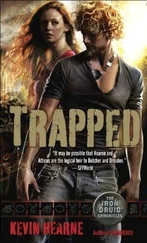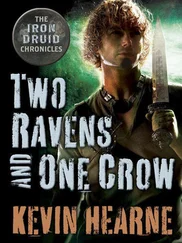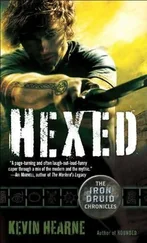
THE IRON DRUID CHRONICLES
BY KEVIN HEARNE
There’s a reason the Navajo Code Talkers were so invaluable to the Marines in WWII. Their language, while beautiful, is really difficult to describe, filled with little glottal stops and special characters and mind-shredding verb constructions like the optative-semelfactive. They have no adjectives but rather use their verbs in an adjectival way. To illustrate how complicated it can get, there is no Navajo word for the verb to give but rather eleven different words that vary depending on the size and shape of what is being given. I don’t use many words of their language in this book, but I’ve done my best to give you a clue about the few you’ll see below. None of them are verbs. Also note that there are regional differences in pronunciation, just as there are different dialects in English, so some of these pronunciations may differ slightly depending on where you are in the Navajo Nation.
Navajo
Áłtsé Hashké = Aht SEH hash KEH (Translates to First Angry , or perhaps First Mad or First Scolder . It’s the proper name of one of the First People, Coyote.)
Áńł’įįh = unn TEE (Means the Witchery Way , or the Corpse-Poison Way .)
ch’įįdii = CHEE dee (A ghost, but specifically the part of one’s spirit that wasn’t in harmony with the universe at the time of death.)
Diné = dih NEH (Means the People . It’s what the Navajo call themselves; the term Navajo was slapped on them by the Spanish and it stuck. In this book, art will imitate life; the Diné will call themselves Diné, and everyone else — including Atticus — will call them Navajo.)
Diné Bahane’ = dih NEH bah HAH neh (Means Story of the People . It is the Navajo creation story, parts of which are sung in various ceremonies.)
Hataałii = hah TAH hlee (This translates to singer , a person who sings at ceremonial occasions and creates sandpaintings, important in many rituals from blessing structures to restoring balance in those who have lost it; in crude terms, a medicine man.)
Hózh  = hoh ZHOH (This means very good , or great energy , everything spiffy and balanced in the world, which English sometimes translates to blessing . To be honest, it doesn’t translate well into English; it’s just one of those words that are too big for Anglo-Saxon noises.)
= hoh ZHOH (This means very good , or great energy , everything spiffy and balanced in the world, which English sometimes translates to blessing . To be honest, it doesn’t translate well into English; it’s just one of those words that are too big for Anglo-Saxon noises.)
Hózh  ji = hoh ZHOH jee (This means Blessing Way .)
ji = hoh ZHOH jee (This means Blessing Way .)
Nílch’i = NIL cheh (Literally, air , but in stories this is the name of the wind. And, yeah, that l with the cross through it doesn’t really get pronounced like an English l , but it’s more of a guttural noise behind your molars; using an l is just an expedient approximation.)
Stunning Sandstone Edifices
Tyende = tee YEH in DEH (This mesa is located about ten miles southwest of Kayenta. Incredibly beautiful sandstone — just don’t be in a wash after a rain. Get to the high ground FAST, because they aren’t kidding about flash floods.)
Wolverines of Especial Interest
Faolan = FWAY lawn (This isn’t a Navajo name, by the way; we’re back to the Irish here.)
Tuatha Dé Danann
Ogma = OG mah (Pronounced og as in log . It’s not like the Ó in Aenghus Óg. That had a diacritical mark over it so you’d pronounce it as a long O . This one’s short. Ogma is credited with teaching Druids Ogham script, among other things.)
The best trick I ever pulled off was watching myself die. I did a respectable job of it too — the dying, I mean, not the watching.
The key to dying well is to make a final verbal ejaculation that is full of rage and pain but not tainted in the least by squeals of terror or pleas for mercy. This was my father’s wisdom — about the only shred of it that has managed to lodge firmly in my mind all these years. He died while trying to steal somebody else’s cows.
It would be an ignominious end today, but before the common era in Ireland, it was honorable and manly to die in a cattle raid, as such theft was called. Before he left to meet his doom, my father must have had some dark premonition about it, because he shared with me all his opinions about dying properly, and I will never forget his final words: “A man’s supposed to shit himself after he dies, son, not before. Try to remember that, lad, so that when your time comes, you won’t make a right girly mess of it. Now fuck off and go play in the bog.”
Like many silly codes of bravery and manliness, the meat of my father’s instruction on how to die well can be distilled to a simple slogan: Die angry at maximum volume. (Dying silently is out of the question; the world’s last Druid should not go gentle into that good night.)
During infrequent spates of morbidity, I used to speculate on my eventual manner of death. I figured it would happen on a city street somewhere, cut off from the power of the earth, unable to summon a magical mulligan that would let me see the sunrise. But at the same time, I hoped it would be in a cool city with a bitchin’ name, like Kathmandu or Bangkok or maybe Climax, Michigan. I never thought it would be in a dried-up place called Tuba City.
Situated in the southwestern portion of the Navajo Nation in Arizona, Tuba City rests on a red sandstone mesa with no visible means of economic support. The first question I asked when I saw it — besides “Where are all the tubas?”—was, “Why is anybody living here?” The red rocks may have a stark beauty to them, but beyond that Tuba City is nearly treeless, dusty, and notably lacking in modern amenities of dubious worth, like golf courses and cafeteria-style dining. It does have a reservoir and some pastures nestled into a canyon, but otherwise it’s puzzling why nine thousand souls would adopt an address there.
On the north end of town, where the BIA Road intersects with Indian Route 6220, a large white water tower juts out of the desert. It overlooks a few dilapidated trailers on the very edge of the city, and then there is naught but a rocky mesa with scattered shrubs gamely trying to make a living in a few inches of sandy soil. I’d flown to the top of the tower as an owl, carrying a wee pair of binoculars in my talons, and now I was camouflaged in my human form, lying flat, and peering northeast into the barren waste where I was about to die.
The dying had to be done. The Morrigan had seen it in a lucid vision, and she doesn’t get those unless it’s really dire and inevitable, like James Earl Jones telling you in his Darth Vader voice, “It is your desss-tiny.” And, frankly, I probably deserved it. I’d been very naughty recently and, in retrospect, epically stupid. Because I couldn’t bear to break my word, I’d taken Leif Helgarson to Asgard to kill Thor and he managed to pull it off, but we killed a few extra Æsir in the process and turned Odin into a drooling vegetable. Now the remaining Æsir were slavering for me to shuffle off my mortal coil, as were several other thunder gods who took Thor’s demise as a personal affront to all things thundery.
After building flaming funeral ships for their dead and resolving to avenge them — for some people approach vengeance like an all-you-can-eat buffet — the Æsir sent Týr and Vidar after the surviving members of our company. I had no idea where Perun or Zhang Guo Lao were hiding, and I hadn’t an inkling of whether Hrym and the frost giants ever made it out of Asgard. Leif was safe, because they saw Thor smash his skull with Mjöllnir; thanks to the peculiar regeneration capabilities of vampires and the dutiful attentions of Dr. Snorri Jodursson, Leif hadn’t quite died, but it would be some time before we knew if he’d make a full recovery.
Читать дальше


 = hoh ZHOH (This means very good , or great energy , everything spiffy and balanced in the world, which English sometimes translates to blessing . To be honest, it doesn’t translate well into English; it’s just one of those words that are too big for Anglo-Saxon noises.)
= hoh ZHOH (This means very good , or great energy , everything spiffy and balanced in the world, which English sometimes translates to blessing . To be honest, it doesn’t translate well into English; it’s just one of those words that are too big for Anglo-Saxon noises.)








